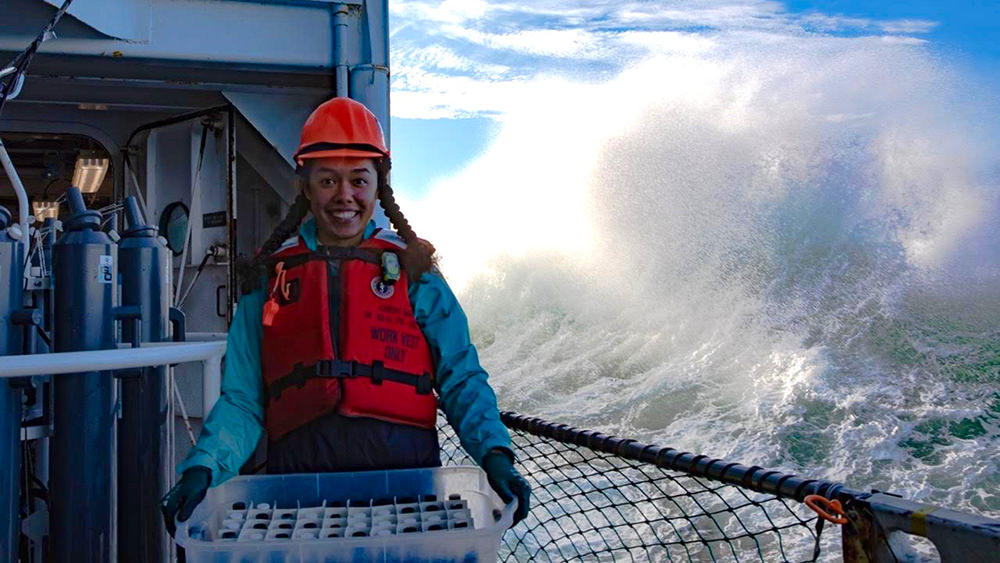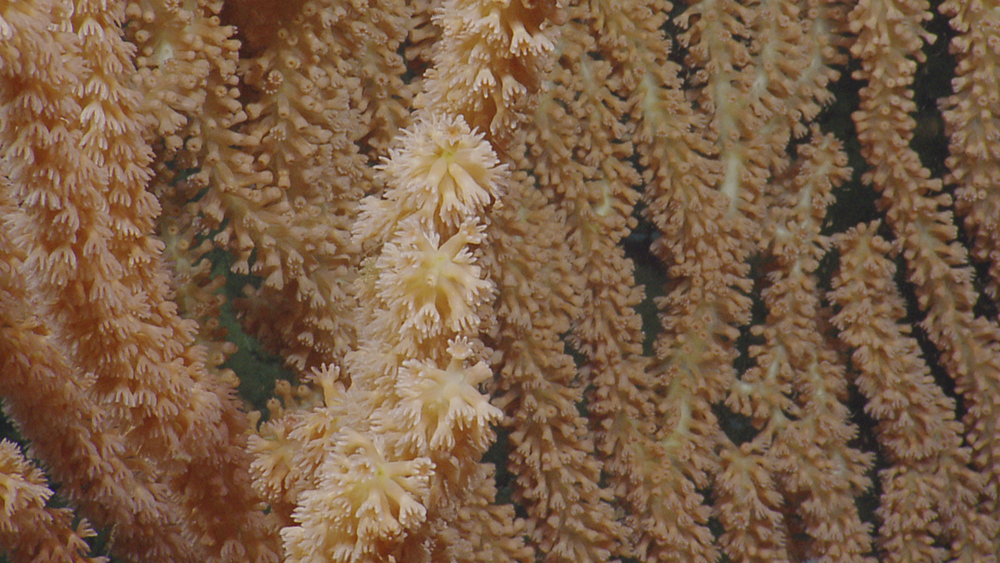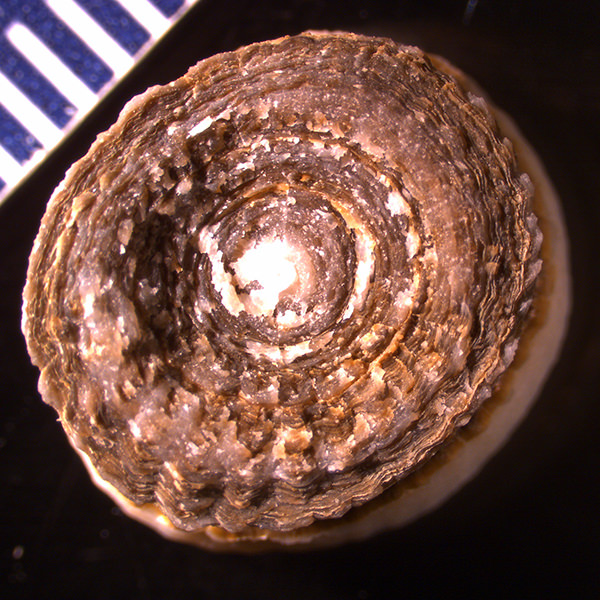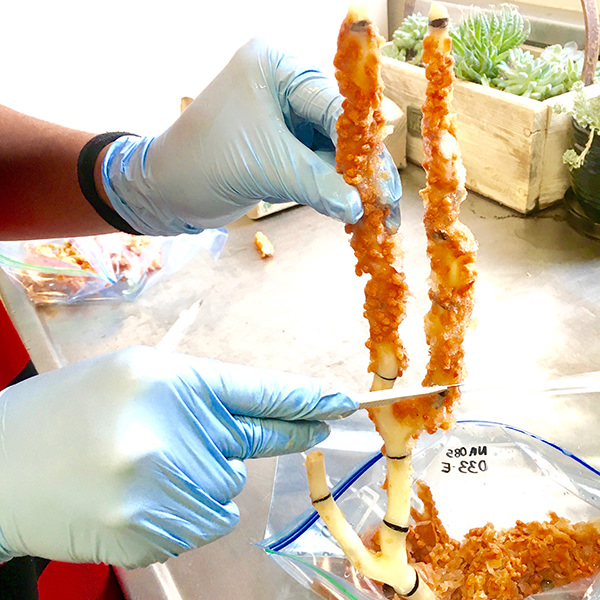Tree rings and deep-sea corals: Coral skeletons teach Foster Scholar Carina Fish about the past ocean
By Yaamini Venkataraman
December 2018
Deep-sea corals have some things in common with trees. As their branches grow, corals document the minute details of ocean chemistry in ring patterns like those in tree trunks. And like certain trees, some coral species can live for hundreds or even thousands of years, preserving their recording of past conditions. Dr. Nancy Foster Scholar Carina Fish uncovers the records kept by deep-sea corals in Cordell Bank National Marine Sanctuary for her Ph.D. at University of California, Davis.
While some oceanographers use sensors to understand the present-day ocean, Fish is also part paleooceanographer, using deep-sea coral skeletons to piece together information about past environmental conditions in Cordell Bank National Marine Sanctuary. Coral skeletons hold useful information about marine food webs and water chemistry. Uncovering the conditions corals were exposed to in the past can provide Fish insight into what deep-sea environments and their overlying surface water have experienced before.

When Fish started her undergraduate career at Harvard University, she didn’t have the opportunity to study marine sciences. She did what she thought was the next best thing: geology. After earning her undergraduate degree and with a preview of geochemistry, she spent two years working at Columbia University in her first paleoceanography job. There, she examined sediment from the seafloor, specifically small plankton shells.
“[Columbia University] gave me a great appreciation for the geological past, and how you can reconstruct past environment conditions from tiny shells in the ocean,” Fish says. “That really stuck with me.”
While not extending as far back in Earth history as with the plankton shells, Fish’s current research focuses on reconstructing past ocean conditions using deep-sea corals from Cordell Bank National Marine Sanctuary. The cold, productive waters of the sanctuary provide habitat for fish and invertebrates, including deep-water corals. However, much of the sanctuary has not been explored. In August 2017, Fish joined a mission led by the sanctuary on board the E/V Nautilus to survey unexplored areas of the sanctuary using the remotely operated vehicle (ROV) Hercules. The team discovered the first bamboo corals ever recorded in the sanctuary and collected a few samples with the ROV at depths up to 2,400 feet.

After collecting samples at sea, Fish takes apart corals in her lab. Corals are made of a living polyp — the actual coral animal, similar to sea anemones and jellies — and a hard coral skeleton the animal builds to maximize the number of food particles it can catch. Fish first separates the polyps from the skeleton and freezes them so that she can later determine the coral’s recent diet. Then, she deals with the coral skeleton.

According to Fish, bamboo coral skeletons are a “beautiful two-part recording.” They are made of a mineral and a protein: calcite and gorgonin. The calcite part of the skeleton records the deep sea’s chemical history, helping researchers understand broader ocean conditions. Fish shaves slices of the chalky calcite skeleton to count its rings and looks for changes in density. Then, peeling back the “tree rings” in the gorgonin section, Fish vaporizes them. In gas form, carbon and nitrogen can pinpoint what the coral ate throughout its life. Molecular building blocks, like carbon and nitrogen, form amino acids. These amino acids have unique signatures that she can trace back to different food sources.


“There are some [amino acids] only synthesized by plants,” Fish explains. “If you see that amino acid in a [coral skeleton], then you know that their food source originally ate a particular kind of plant. You can then reconstruct what was at the base of the food web during that time.”
At the end of this meticulous work, Fish can look for trends in both an individual skeleton and across all the coral skeletons she collects. Climate change can impact the surface of the ocean through rising temperatures and chemical changes, but it can be hard to tell if those changes are impacting organisms on the seafloor. By connecting deep-sea corals and their food sources, Fish links the changes at the surface with deeper water. If environmental changes are impacting coral food sources at the surface, then those same changes can indirectly impact the deep sea. For example, each coral grows at a different pace, but if several corals have the same growth pattern, then Fish can search for clues in the environment — warmer waters, changing oxygen or carbon content — that could have affected the corals and their food sources.
Although Fish’s research focuses on the past, her work is part of an exciting present initiative to explore the depths of Cordell Bank National Marine Sanctuary — just collecting her coral samples is novel.
“We don’t know much about deep-sea corals in general. They are pretty hard to access: you need a ship and two robots just to get down there,” Fish says. “Deep-sea exploration is like going to the moon. The novelty of exploring [the deep sea] is still valuable.”
Inside the E/V Nautilus control van — her version of mission control — Fish can explore the deep sea. She watches live footage from the ROV Hercules as it cruises along the Cordell Bank National Marine Sanctuary seafloor. Moving through the pitch-black ocean, the ROV looks like a rover in the middle of outer space. Fish points at the screen: she sees a bamboo coral. The ROV pilot gets the ROV in position to sample the coral. Fish’s exploration is just beginning.
Yaamini Venkataraman is a volunteer social media intern for NOAA’s Office of National Marine Sanctuaries and a graduate student at the University of Washington.
Graduate Student Spotlight: The Dr. Nancy Foster Scholars
NOAA's Dr. Nancy Foster Scholarship Program provides graduate students in oceanography, marine biology, maritime archaeology, and coastal and ocean resource management with financial support and tools for success inside and outside graduate school. The program seeks to increase the number of women and minorities in these scientific disciplines, particularly as they relate to the mission of the NOAA Office of National Marine Sanctuaries. In this series, we highlight the diverse perspectives on research and engagement held by our current scholars.
More Information

